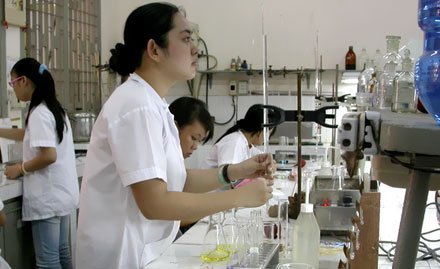
Foreign investment attraction hotspots Ho Chi Minh City and the provinces of Binh Duong, Dong Nai, and Ba Ria-Vung Tau have continuously stressed the need for scientific and technological developments, based on positive changes in policy and strategy, and international cooperation, contributing to the development of the country.
Foreign investment attraction hotspots Ho Chi Minh City and the provinces of Binh Duong, Dong Nai, and Ba Ria-Vung Tau have continuously stressed the need for scientific and technological developments, based on positive changes in policy and strategy, and international cooperation, contributing to the development of the country.
 |
| Scientific and technological development is a key to Vietnam's economic expansion |
Last year, Saigon Hi-Tech Park (SHTP) attracted 66 investment projects with total capital of US$ 2.2 billion, including 33 FDI projects worth of US$1.78 billion and 33 domestic invested projects worth US$430 million. Ho Chi Minh City (HCMC)’s microchip and electronic sector will strive to reach US$150 million in sales by 2017, offer training for about 2,000 engineers and technicians, and register around 30 new IC producers. To highlight the key role of science and technology development in the city’s socio-economic development, Deputy Chairman of the HCMC People’s Committee Le Manh Ha said that the city authorities would not limit spending on science and technology development in order to resolve flooding and traffic problems.
Dong Nai is also focusing on scientific and technological developments especially in terms of their research and application to develop local services and production, plus also organizing science and technology fairs and workshops, including the coming Conference on Information Technology-Communications XVI Vietnam, Seminar on Social Science and Sustainable Development in South East Asia, and workshop on export-orientated honey production.
One of the outstanding results of Dong Nai’s science and technology sector last year was to promote the implementation and monitoring of investment projects to develop scientific and technological resources such as sub-project for a road linked to the Dong Nai Biotechnology Center which is being completed; construction projects for the Center for Standards, Metrology and Quality in Nhon Trach. In addition, the sector also called for infrastructure investment in biotechnology research undertaken by research institutes and universities. Director of Dong Nai Department of Science and Technology Pham Van Sang said, “Dong Nai will continue to promote scientific and technological development focusing on agriculture, rural development, green technology, and biotechnology so as to attract human resources into the local science and technology sector.”
Last year, Binh Duong Province completed several key scientific and technological research and application projects including corporate data integration solutions to improve local State agency management; a set of regulations on local wastewater reuse for the rubber processing and livestock industries.
According to Vice Chairman of Binh Duong’s People’s Committee Le Thanh Liem, the provincial science and technology sector aimed to contribute about 35 percent of Binh Duong’s socio-economic growth by 2020, with annual rates of technological innovation and equipment reaching from 10-12 percent during the 2013-2015 period and 20-25 percent during the 2016-2020 period, and transaction value for the science and technology market increasing by an average of 15-17 percent per annum. The sector will also strive to attract private investment into local scientific and technological development with a view of absorbing total investment equivalent to 1.5 percent of the provincial GDP by 2015 and more than two percent by 2020. “We will encourage and support organizations and individuals to implement intellectual property development projects of high application,” he said.
In the near future, Binh Duong will focus on the innovation of management mechanisms, improved scientific and technological activities, and high-quality human resources development towards new and modern technology, development and implementation of inter-sectoral programs.
(Source: VEN)





